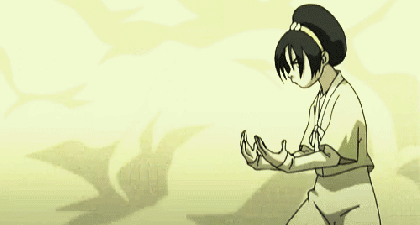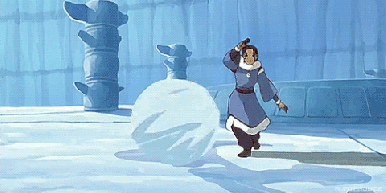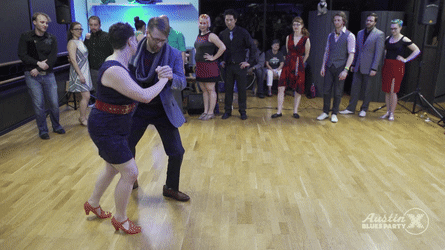On Avatar: the Last Airbender and Intentional Blues Dance Practice
Lately, Jeff and I have been watching a lot of Avatar: the Last Airbender. For the uninitiated, Avatar is an animated show that aired on Nickelodeon from 2005-2008. In the Avatar world, some percentage of the population has the ability to psycho-kinetically manipulate different natural elements (Air, Water, Earth, and Fire); an ability called Bending. Which element an individual can Bend is generally determined by the culture or tribe into which they were born. A Bender born into the Earth Kingdom would be an Earthbender. A Bender born into the Water Tribe would be a Waterbender, and so forth. In addition, Benders typically have personality traits (and sometimes physical traits) that are aligned with their Element. The Avatar is the only one capable of Bending all four elements.
Even though it was written for the 10-12 year-old demographic, we love this show. It’s charming, characters show actual development, and actions have real and meaningful consequences. Also, they have the best hybrid animals. However, the point of this post is not to gush about the adorableness of saber-tooth moose lion cubs (but really, they are adorable).
The Point of This Post
One night, Jeff asked the fateful question, “as a dancer, what kind of Bender would you be?” Since then, we’ve been conducting an ongoing thought experiment about what kind of Benders we are, and why. It’s been fascinating to think about how we dance as individuals, how that translates into which elements we are best suited to Bend, and more importantly, what we can do with that information. It was immediately apparent to both of us that Jeff is an Airbender, through and through (I’ll explain why in a bit). It took a little more thought to identify my tribe, but we eventually decided that I’m a Firebender. Taking it a step further, we started considering how our elements might interact, and what we could learn about our partnership from that. It became stunningly apparent that in addition to being excellent dinner conversation, Bending could be a powerful tool for dance diagnosis, developing self-awareness, conducting intentional practice, and even for thoughtful performance in competition.
A Primer on Blues Dance Bender Types
Before delving into the applications of Bending to Blues Dance, we felt it was important to provide an introduction to the four elements and their characteristics. Through analyzing Benders from the tv show, and with some thoughtful interpretation of the elements themselves, we developed the following descriptions of each Blues Dance Bender.
Airbender

Airbenders are the mad scientists of blues dance. Highly creative, they love to take risks on exciting ideas that have never been seen before, and often invent or discover new moves. Their approach to dance is highly intellectual, always thinking about how they can play with dynamics, make surprising choices, subvert expectations, and highlight interesting aspects of the music. Airbenders love to have fun, and generally don’t take themselves too seriously, so dances with them often end up in laughter. Musically, they love to explore lyrical elements, intricate rhythms, and interesting details. They love playful interactions, and are often motivated by trying to surprise or delight their partners. At times, Airbenders can become overly wrapped up in their ideas, and may have difficulty connecting with their partner or with an audience.
Earthbender

Earthbenders are strong, confident, and decisive. They dance with power and clarity. They feel totally at ease holding their ground and will wait for the right moment to make a move. They are certain in their choices, and take the time needed to execute them the way they should be, whether that means collecting their own energy, or making sure their partner is ready. Once they’ve made a decision, Earthbenders will move with great impact, intensity, and even speed. They are adept at balancing excellent listening skills with commitment to their own ideas. Earthbenders are generally dominant as dance partners, yet inviting, and others will enthusiastically join in on their vision. Their dancing and ideas evolve over the course of a song, sometimes so subtly that you may not even notice the changes happening. Self-assured in holding their space, they may end up traveling less than their partners, or lagging more. At times, they can be stubborn, unyielding, or miss subtle signals. Earthbenders also like to be supportive of their partners, allowing them the time and space needed to express their ideas (but won’t necessarily yield to them, at least, not until they’re ready).
Waterbender

Waterbenders excel at taking ideas and turning them into something extraordinary. Their ability to complete, embellish, improve, and innovate on ideas makes their partners feel like dance masters. They love to develop amazing dances collaboratively. Waterbenders are highly adaptable, responsive, and easily flow with their dance partners, the music, and their own bodies. They intuitively highlight and bolster their partner’s strengths, making each dance with each partner greater than sum of its parts. They use their creativity to mold and innovate on raw dance material, taking it to new heights (or depths). Waterbenders are capable of taking their dances in surprising directions, but in a way that feels totally natural in the moment. They thrive on being given interesting shapes, directions, and musical concepts to play with, develop, and improve upon. Sometimes, they can get carried away with the flow, becoming aimless and directionless, relying too heavily on their partner to move them, or trying too hard to match their partner.
Firebender

Firebenders are radiant and charismatic. They tend to draw attention, and may outshine or out-flash their partners, although not always intentionally, and not always by dancing *more* or *bigger*. They have strong ideas, and rarely hesitate to express them. They can be highly responsive dance partners, and when given a direction, shape, or idea, they can choose to flow with it, but will do so entirely on their own terms. Firebender dancing is instinctive and complex; even if it’s small and subtle, it has a lot going on. They like to take risks, and are unabashed in their choices. Left unchecked, Firebenders might overpower or ignore their partners, show-off too aggressively, or escalate ideas too far.
A Note About the Types
It’s important to note that Bending abilities in dance are reflective of a dancer’s mental and philosophical tendencies; not their physicality, how they look, or even how they actually move (although these things can align). An Airbender can be large and muscular, and an Earthbender can be petite and lithe. When you read these descriptions, and try and identify yourself in them, we encourage you to focus more on your approach to dance, and less on the shape of your body or physical manifestation of your dance.
Most Dancer Benders have dominant traits that determine their “home” element, but will incorporate techniques from various elements into their blues dancing. And in fact, the most powerful Benders in Avatar: the Last Airbender are highly adept at techniques borrowed from other elements. King Bumi is a tremendous Earthbender with the humor and eccentricity of an Airbender. Iroh’s Firebending is terrifying (do you know why they call him the Dragon of the West?), but he has the compassion and easygoing nature of a Waterbender.
Many traits are also found across the elements, such as creativity, power, intuition, and intelligence, but will manifest with a different texture or flavor in each. Therefore, when trying to identify your Bending type, you should consider not just the traits themselves, but *how* you use them. And we have our own thoughts about who the Avatar is (okay fine, it’s Remy Kouakou Kouame, seriously).
Finally, determining one’s element is a subjective art. We asked two different people what kind of Bender they thought I was; one said I was an Earthbender (and a few years ago I would absolutely have said the same thing), and another said I was a Waterbender. I have no problem with this; it simply means they were responding to different things in my dancing.
Identifying Your Type
Let’s break down how we came to the conclusion that Jeff is an Airbender, and that I am a Firebender. When we thought about which traits are most dominant in Jeff’s dancing, humor, intelligence, dynamism, and creativity immediately came to mind. He also loves to create new moves and surprising moments. This combination is strongly aligned with Airbending. We felt that the most dominant traits in my dancing are assertiveness, independence, complexity, and instinct. I also love performing and being in front of an audience. All of which are more akin with Firebending. Of course, we both inhabit characteristics of other elements, as do pretty much all blues dancers (Jeff’s James Browns are very Water-aligned, and my groundedness is very Earthy, for example), but we think of those as techniques that we apply within our natural state.
What can we learn from this?

Thinking of Jeff as an Airbender and Shoshi as a Firebender then allowed us to consider the possible implications for our dancing. Theorizing how our elements might interact and affect our partnership, we could use that knowledge to strengthen our dancing together. Bending could also highlight our strengths as individuals, or identify potential pitfalls we need to be mindful of. We could then apply that insight to develop more effective practice sessions, and improve our social dancing and competition performance.
Thinking about how Fire and Air work together, some clear strengths of our partnership are creativity, risk-taking, energy, humor, charisma, intensity, complexity, dynamism, instinct, and intellect. This combination lends itself to exciting, memorable, and thought-provoking dances. However, with Fire and Air you also run the risk of explosion and acceleration. Untempered, our dancing could become confusing, silly, unpredictable, or even dangerous. Consequently, we need to think about ways to keep our energy focused and directed so we don’t burn out of control. Additionally, since Airbenders love lots of ideas, and Firebenders love complexity, our partnership would benefit from exploring simplicity.
As a Firebender, some of my potential weaknesses are prioritizing my own dancing over my partner’s, or overpowering them. To work on this, I could intentionally listen to, and highlight, my partner. Conversely, I could nurture and develop my strong-minded tendencies by trusting my instincts and letting my ideas shine. As an Airbender, Jeff runs the risk of becoming aloof or evasive in his dancing, or overwhelming the dance with too many ideas. His practice would benefit from dancing directly at his partner, and holding on to moments for longer. However, practice is also the time to take risks, so Jeff could allow his creativity absolute free reign to see where it takes him, or even explore detachment as an intentional attitude. Looking at what Air and Fire have in common, as individuals, each of us would benefit from highlighting and focusing on our partner’s voice and vision.
We should also look to the other elements, particularly our opposites, for guidance. Air and Earth are elemental opposites, which means that for Jeff, Earthbending techniques would be the hardest to master. To help with this, we could develop exercises about waiting, patience, or stillness. As a Firebender, Water would be my opposite, which means I would probably benefit from exercises where I practice yielding more to my partner’s ideas, or letting them move me.
Another approach to using Bending in our dance practice is remembering that we embody traits across the elements. If other people see me as an Earth or Waterbender, I can embrace that, and intentionally foster those characteristics in my dancing. I could just as easily conduct a practice where I focus on my Earth and Waterbending techniques as on my Firebending. How would my fiery creativity manifest if I were channeling my Earthbending? What texture would my power have if I were Waterbending? I could even play with the idea of adding some “ice” into my dancing (which would honestly be pretty exciting to see in a Firebender!).
This also has applications in competition settings. If Jeff is paired with a Waterbender in a jack and jill, he can think about how to best support the strengths of his partner. Waterbenders are highly responsive and innovative, so Jeff might give them interesting spaces to fill, and create structure for them to play off of. Whereas, if he’s paired with another Airbender, he might do more call and response, to allow each partner the space to express their ideas, to dance around and with each other, but not talk “over” each other. And with an Earthbender, he might hold on to his ideas for longer, because Earthbenders like to delve deeply and evolve more slowly.
Bending and the Africanist Dance Aesthetic
Another layer to this is how the different elements and Bending techniques align with the Africanist dance aesthetic. Consider the components of the Africanist dance aesthetic as outlined by Brenda Dixon Gottschild: Ephebism, Conflict, High Affect Juxtaposition, Aesthetic of Cool, and Polyrhythm/Polycentrism. Arguably, in order to effectively embody the Africanist dance aesthetic, a dancer needs to be able to implement techniques across the elements. Firebenders might be the first to embrace conflict, but unless they can embody the collaborative spirit of Water or the humor of Air, then there will be no contrast. Earthbenders have the vitality and intensity of ephebism, but without the multifaceted nature of Fire or Water’s flexibility, then they will probably struggle with Polycentrism and Polyrhythm. Airbenders have a sense of ease and detached cool, but it’s the intensity of Earth or the danger of Fire that creates the necessary juxtaposition. Within each of the elements are pieces of the Africanist dance aesthetic, but without intentional practice in the techniques of each, it is impossible to fully embody the dance.
In Conclusion
The possibilities for intentional practice inspired by Bending are essentially limitless, as are the implications for developing and creating new ideas within dance partnerships. It’s also a great way to start thinking about who you are as a dancer, what inspires you, and how to identify your fundamental strengths and tendencies. Our descriptions are not meant to be the final word on how to identify different Benders, but a starting point to help you conduct your own self-analysis. We encourage you to consider which attributes you personally associate with Air, Water, Earth, and Fire. You can create a rubric for yourself to begin exploring which type of Bending inspires you the most, or aligns most closely with your dancing. We hope you will use this framework in the spirit it was presented, as a creative way to practice your blues dancing, develop self-awareness, and inspire thought-provoking conversation.
Happy Bending!

One thought on “On Blues and Bending”